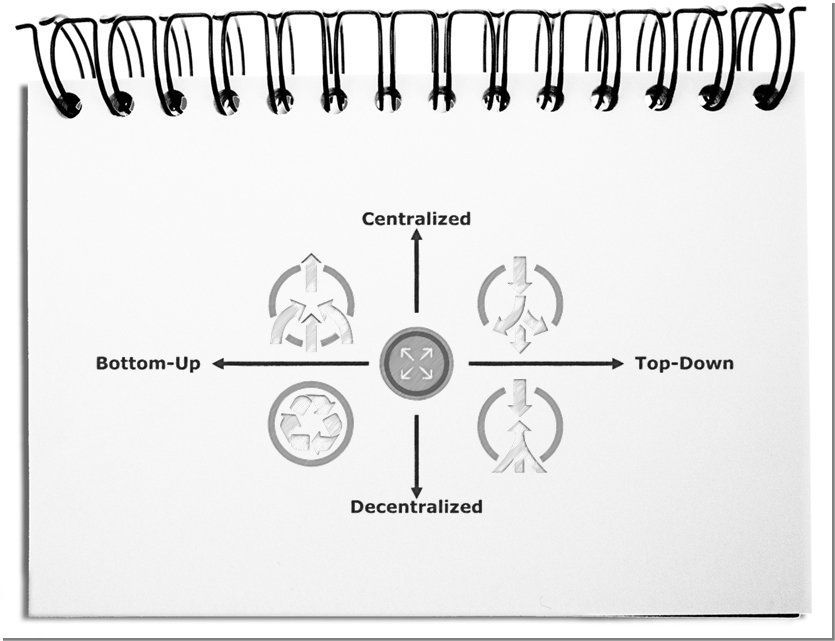One of the hurdles on the way to agility and entrepreneurship, vibrant corporate culture, and a secure psychosocial climate, genuine self-management, and intrinsic commitment are the decision-makers. With the transfer of authorities to act and distributed self-organization, they lose their raison d’être. In doing so, they overlook the fact that these new approaches are above all an expression of their inability to come up with coherent structures that prevent the crash into anarchy. Leadership was effective in the evolution until the number of members reaches the range of the Dunbar number – our ability to handle no more than about 150 people. At the same time, we can resist the modern demands for more employee independence. As a result, some leadership styles are not available in the future – dictatorship, rigid chains of command, Micromanagement.
The two areas that management always has to deal with are the distribution of roles (i.e., centralized vs. decentralized) and the way decisions are made (i.e., bottom-up vs. top-down).
- Fragmented approach
The extreme of anarchy already begins when the leaders leave decisions to the distributed workers, and they enforce their wishes from the bottom up without aligning with each other. With this fragmented approach, all decentralized aspects would be considered, but there would be no coordinated, holistic procedures. As a consequence, each location is an independent unit that decides locally, has its uncoordinated approaches and its view of what is happening, and acts in accordance with the situation.
The company degenerates to an adhocracy with a formal holding without any task. - General approach
Without taking the needs of the sites into account, it is no longer possible to find viable approaches. A bottom-up approach using measures to be coordinated, possibly over several stages, is the way out of an intangible confusion of intentions. The prerequisites are a common stance and early consideration of the individual points of view. For this purpose, existing implementations are readjusted at various levels. Unique features that have already been considered are sacrificed retrospectively in the interest of all – the sections must request decisions from the higher-level area and follow coordinated, bureaucratic procedures to finally obtain a necessary result.
The enterprise forms a bureaucracy with several levels and becomes a rigid apparatus with elaborate decisions, a lot of duplication of work, and rework. - Joint approach
A framework that is given from the top allows unnecessary efforts to be intercepted in advance. With the help of an overarching strategy, a collective self-image, a binding corridor of action, and a joint code of conduct, the decentralized units can introduce and realize their needs as long as they remain within the framework. Here, too, the locations must dispense with desired special features, can adopt joint achievements, and propose decisions. Together they develop reusable building blocks, coordinated processes, and mutually complementary results.
The company becomes a democracy with clear orientation and common rules. - Concentrated approach
The extreme of the rigid head office begins when the needs of the locations are ignored, and a top-heavy headquarter to the operative departments dictates what to do – without ever doing anything practical. In this approach, the individual departments (Purchasing, Human Resources, Strategy, Product Management, Sales, etc.) generate specifications for the locations. However, despite all the centralization, there are no cross-departmental requirements. Instead, each department perfects itself at the expense of the others – every person for oneself. Insufficient contact with the basis, green table decisions, and lack of responsibility generate internal disruptions that damage profitability. At the same time, however, company-wide decisions and structures become possible, with reliable processes and a valid result.
The enterprise degenerates to an autocracy with a power structure far from the real world, which is not viable, since not only a lack of understanding prevails and inappropriate decisions happen, but at the same time, the energies of the locations remain unused.
Bottom line: The reason why old wine is always being filled into new tubes is that managers no longer have the answers to today’s VUCA world. The business is no longer manageable or predictable. There is a lack of stable structures to align with. Every simulation of the business provides nothing more than probabilities, which are destroyed by the next Black Swan. The speed at which the world is changing no longer permits chains of command but requires waves of inspiration that stimulate everyone. It no longer works without the interaction with on-site people – in the R&D the open exchange of ideas, in Production the transparency of the product, in Sales the understanding of the customer or in After Sales the availability of known solutions. On-site are the skills that make excellent performance possible. If the managers could manage these potentials in such a way that they produce viable results for the company, then, in the future, we would again have a meaningful management involvement.

